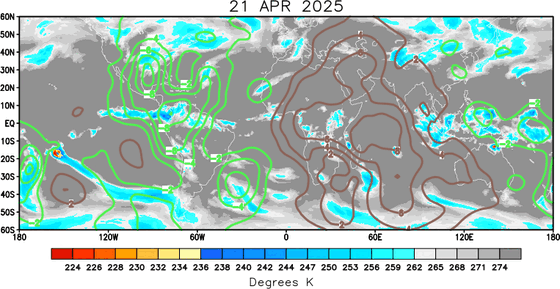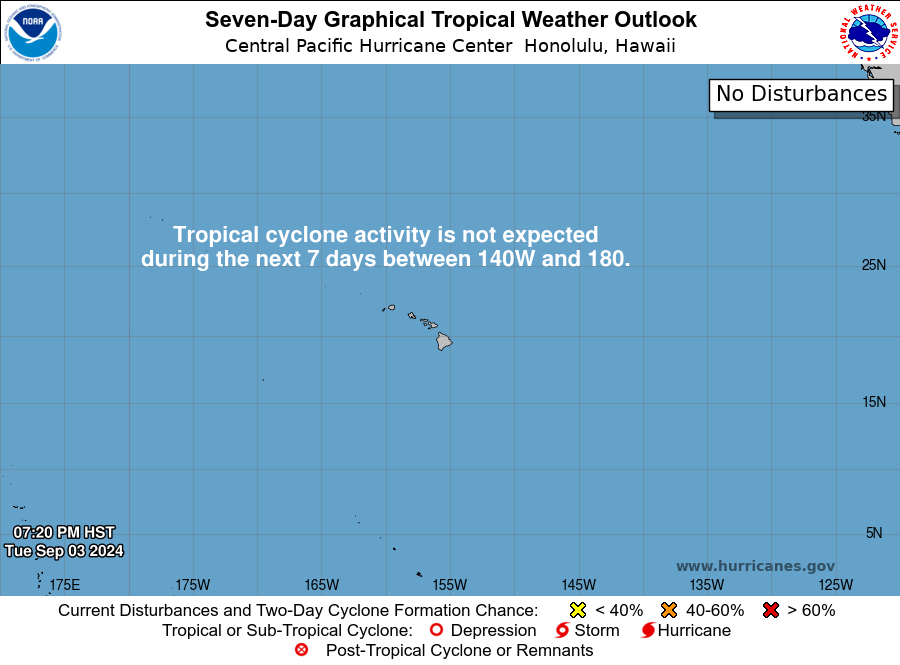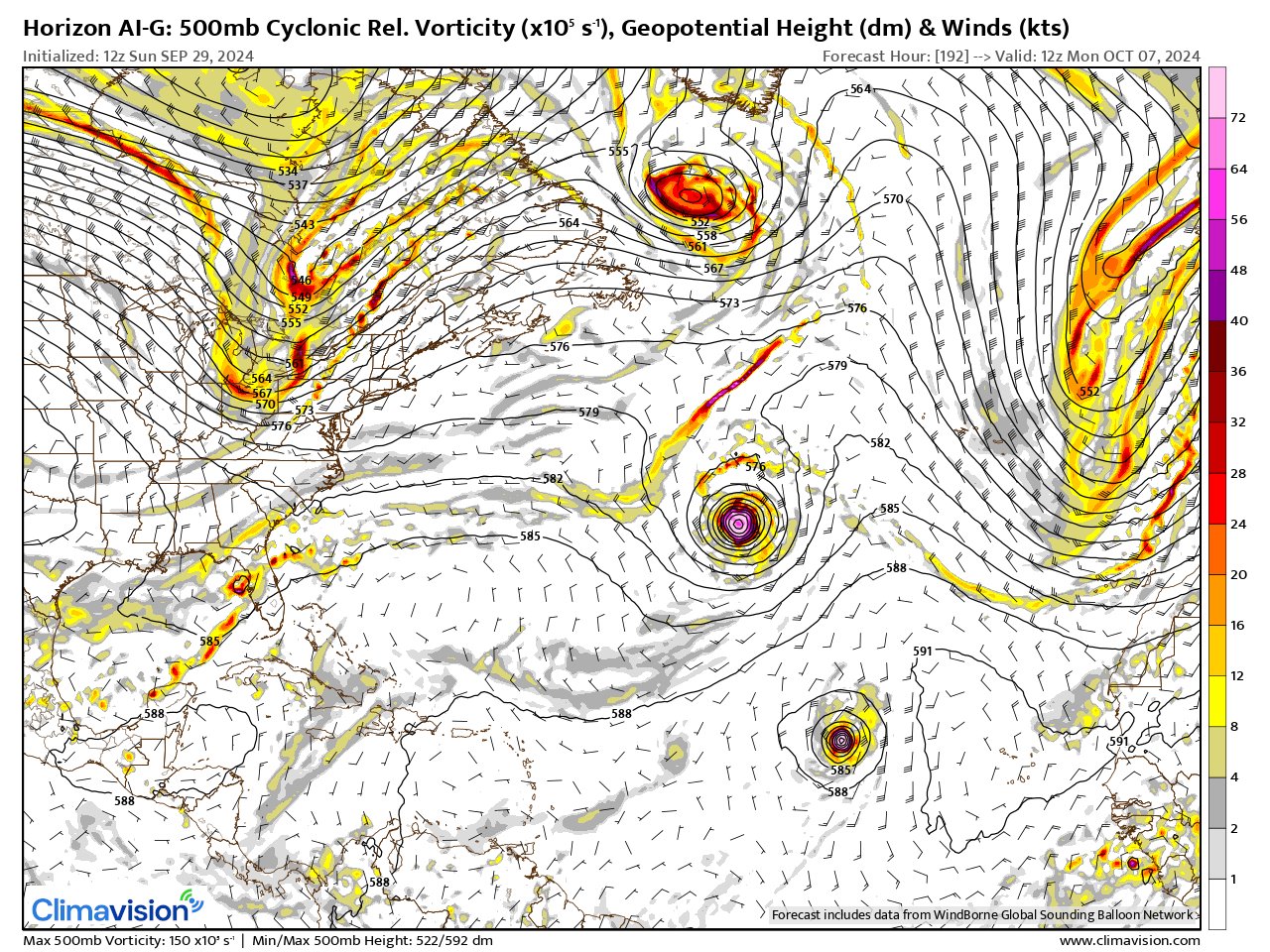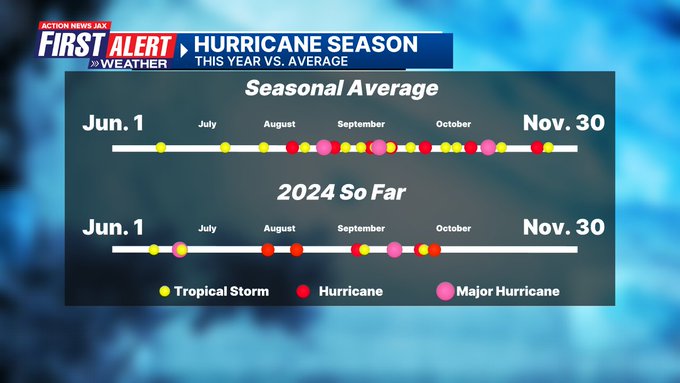Jacksonville, Fl. — The “Buresh Bottom Line”: Always be prepared!.....First Alert Hurricane Preparation Guide... City of Jacksonville Preparedness Guide... Georgia Hurricane Guide.
STAY INFORMED: Get the * FREE * First Alert Weather app
FREE NEWS UPDATES, ALERTS: Action News Jax app for Apple | For Android
WATCH “Preparing for the Storm”
WATCH “The Ins & Outs of Hurricane Season”
READ the First Alert Hurricane Center “Preparation Guide”
Federal Alliance for Safe Homes (FLASH) * here *.
***** ALWAYS CHECK & RE-CHECK THE LATEST FORECAST & UPDATES! ****
Tropics threats for Jacksonville/NE Florida/SE Georgia: None.
“Buresh Bottom Line”:
* “Kirk” will become a large & strong hurricane over the Eastern & Central Atlantic followed by T.D. #13 which will become “Leslie”.
* Eye on potential tropical development over or near the Caribbean & Gulf of Mexico during the upcoming 5-10 days.
The Atlantic Basin Overview:
(1) Low pressure is again forecast to form from a trough of low pressure over the Western Caribbean that moves northward over the Gulf of Mexico with potential gradual tropical development in the longer term - roughly in the period Oct. 4 - 11th.
Forecast models continue to show mixed signals with poor consistency though that inconsistency has been particularly high this week. As a whole... global models have recently trended generally trended weaker & more south BUT the models could always reverse this trend too, of course. The GFS is now showing a weaker system into the weekend with a possible tropical system organizing over the Eastern Gulf then its energy gets transferred to a low east of Florida & becomes stronger while moving east (was erratic but consistently strong w/ Helene)... the European model is slower, weaker & farther south (had a slow, weak & west bias with Helene) keeping a weak tropical cyclone now mainly over the Central Gulf that moves east across Fl. next week then strengthens while moving away over the W. Atlantic... & the Canadian model is stronger & in-between the GFS & Euro with a hit on the Fl. west coast by the middle of next week. The Climavision ‘Horizon AI’ global model was quite strong & pointed to the Big Bend (again!) but has recently trended a bit south & definitely not as strong. The ‘Horizon’ was quite good with Helene. The model shows the system to be near Fl. much of next week & points to a very wet scenario for the sunshine state. Overall - the global long range forecast models are showing a more disorganized, at times multiple low pressures vs. a strong hurricane. But beware! - this could always change... & there is a pretty consistent signal for at least several days of heavy rain for parts of Florida this weekend into the following week.
I feel the models are generally having problems - again - with the extensive low pressure at low (southern) latitudes.
Suffice to say at this point the area will need to be closely monitored. It does appear an upper level - 500mb - trough of low pressure diving down into the Eastern U.S. will have a lot to do with where the eventual possible Gulf low might go. A deeper trough will tend to draw any disturbance northward. However, if the trough axis is far enough east, the disturbance could get shunted more east before turning north or northeast. Bottom line is it’s still too early to determine exactly what will come of the eventual Gulf disturbance & where it might go.
Climavision’s HorizonAI Global Model (this model uses its own data & analysis for initialization of each model run + some AI input) valid for late Mon., Oct. 8 (trend is slower, a bit more south & weaker):
This is the ‘Horizon’ 500 mb (upper level) forecasts for early Mon., Oct 7th showing the digging trough into the Northeast U.S. with more of a “baggy” trough to the south interacting with a possible Gulf low. It’s possible the strong trough could miss the Gulf low complicating the ultimate track & intensity scenario even more.
GFS 500mb forecast for this Sunday. The persistent alleyway over the Central Atlantic looks like it stay intact effectively protecting the U.S. & Caribbean from strong tropical cyclones over the Eastern Atlantic:

7-day forecast rainfall:


(2) “Kirk” has quickly formed & strengthened over the Eastern Atlantic. Kirk became a hurricane Tue., the 7th of the Atlantic season which does not occur until Nov. 15th in an “average” season. Kirk will turn northward early on keeping the storm far away from the Caribbean or U.S. & far to the east of Bermuda. The Bermuda High remains weaker & displaced to the east/northeast allowing for a nice & early alleyway over the Central Atlantic which Eastern Atlantic tropical systems can follow keeping them far from any land areas & certainly well east of the Caribbean & U.S. The average date for the 11th named storm is Sept. 14th so nothing at all unusual right now vs. climatology when it comes to named storms vs. the avg. Atlantic hurricane season.
(3) Tropical depression #13 has formed right behind - to the east of - Kirk & will become “Leslie”. Like Kirk, sister Leslie will stay well out to the east over the Central & Eastern Atlantic:




‘Velocity potential anomalies’ below shows far less “sinking” air (brown lines) spreading across the Pacific Basin. With sinking air, tropical development can occur but overall conditions are not as conducive as when there is overall rising (green lines) air where convection is active. This “pulse” of upward motion has moved eastward & likely helped Helene & other Atlantic tropical cyclones & is about at its peak.

REMEMBER WHEN A TROPICAL STORM OR HURRICANE IS APPROACHING: Taping windows is *not* recommended & will not keep glass from breaking. Instead close curtains & blinds.
Realize the forecast cone (”cone of uncertainty”) is the average forecast error over a given time - out to 5 days - & *does not* indicate the width of the storm &/or where damage might occur.
The upper oceanic heat content (UOHC) [tropical cyclone heat potential/TCHP] across the SW Atlantic, Gulf & Caribbean is very high:






Water vapor loop (dark blue/yellow is dry mid & upper level air):


October tropical cyclone origins:
Averages below based on climatology for the Atlantic Basin for October:
Wind shear (red - strong shear; green - low shear):



Saharan dust spreads west each year from Africa driven by the prevailing winds (from east to west over the Atlantic). Dry air = yellow/orange/red/pink. Widespread dust is indicative of dry air that *can* interfere with the development of tropical cyclones. However, sometimes “wanna’ be” waves will just wait until they get to the other side of - or away from - the dust plume then try to develop if other conditions are favorable (we’ve already seen this with Beryl & Debby this year). In my personal opinion, there is way too much “hoopla” about the presence of Saharan dust & how it relates to tropical cyclones. In any case, the peak of Saharan dust typically is in June & July.

2024 names..... “Leslie” is the next name on the Atlantic list (names are picked at random by the World Meteorological Organization... repeat every 6 years). Historic storms are retired [Florence & Michael in ’18 (the last time this year’s list was used)... Dorian in ’19 & Laura, Eta & Iota in ‘20, Ida in ‘21 & Fiona & Ian in ‘22]). In fact, this year’s list of names is rather infamous because of the ‘04 season when Charley, Frances, Jeanne & Ivan - all retired names - hit Florida within a matter of about 6 weeks. The WMO decided - beginning in 2021 - that the Greek alphabet will be no longer used & instead there will be a supplemental list of names if the first list is exhausted (has only happened three times - 2005, 2020 & 2021). The naming of tropical cyclones began on a consistent basis in 1953. More on the history of naming tropical cyclones * here *.

Peak of the hurricane season Sept. 10th:




East Atlantic:





Mid & upper level wind shear (enemy of tropical cyclones) analysis (CIMMS). The red lines indicate strong shear:
Water vapor imagery (dark blue indicates dry air):

Deep oceanic heat content over the Gulf, Caribbean & deep tropical Atlantic. The colors will brighten greatly as the water warms to greater depths deeper into the season:

Sea surface temp. anomalies:


SE U.S. surface map:

Surface analysis centered on the tropical Atlantic:

Surface analysis of the Gulf:

Caribbean:

Atlantic Basin wave period forecast for 24, 48, 72 & 96 hours respectively:





East & Central Pacific:
A Tropical Storm WARNING: Lagunas de Chacahua to Boca de Pijijiapan.






Central Pacific:

Hawaii satellite imagery:


West Pacific:

Global tropical activity:

“Jebi” stays just east of Japan:

“Krathon”:
Impacting Taiwan this week...

“Ancha”:



Cox Media Group















